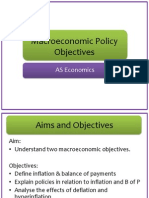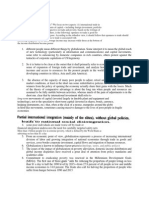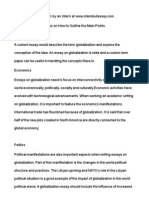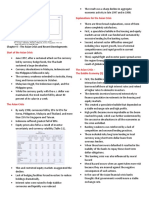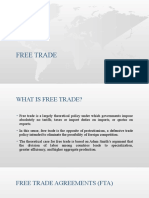100%(1)100% found this document useful (1 vote)
181 viewsWhat Is Absolute Advantage?: Adam Smith and The Theory of Absolute Advantage
What Is Absolute Advantage?: Adam Smith and The Theory of Absolute Advantage
Uploaded by
Nicki Lyn Dela CruzAdam Smith introduced the concept of absolute advantage in his seminal work "The Wealth of Nations" in 1776. Absolute advantage refers to a country's intrinsic ability to produce a good at a lower opportunity cost than competitors. Smith argued that countries should specialize in producing goods where they have an absolute advantage and trade for other goods, allowing all countries to gain. He believed differences in technology between nations drove international trade patterns. Smith's theory of absolute advantage supported his argument for laissez-faire policies and unrestricted international trade.
Copyright:
© All Rights Reserved
Available Formats
Download as DOCX, PDF, TXT or read online from Scribd
What Is Absolute Advantage?: Adam Smith and The Theory of Absolute Advantage
What Is Absolute Advantage?: Adam Smith and The Theory of Absolute Advantage
Uploaded by
Nicki Lyn Dela Cruz100%(1)100% found this document useful (1 vote)
181 views1 pageAdam Smith introduced the concept of absolute advantage in his seminal work "The Wealth of Nations" in 1776. Absolute advantage refers to a country's intrinsic ability to produce a good at a lower opportunity cost than competitors. Smith argued that countries should specialize in producing goods where they have an absolute advantage and trade for other goods, allowing all countries to gain. He believed differences in technology between nations drove international trade patterns. Smith's theory of absolute advantage supported his argument for laissez-faire policies and unrestricted international trade.
Original Title
Adam smith theory
Copyright
© © All Rights Reserved
Available Formats
DOCX, PDF, TXT or read online from Scribd
Share this document
Did you find this document useful?
Is this content inappropriate?
Adam Smith introduced the concept of absolute advantage in his seminal work "The Wealth of Nations" in 1776. Absolute advantage refers to a country's intrinsic ability to produce a good at a lower opportunity cost than competitors. Smith argued that countries should specialize in producing goods where they have an absolute advantage and trade for other goods, allowing all countries to gain. He believed differences in technology between nations drove international trade patterns. Smith's theory of absolute advantage supported his argument for laissez-faire policies and unrestricted international trade.
Copyright:
© All Rights Reserved
Available Formats
Download as DOCX, PDF, TXT or read online from Scribd
Download as docx, pdf, or txt
100%(1)100% found this document useful (1 vote)
181 views1 pageWhat Is Absolute Advantage?: Adam Smith and The Theory of Absolute Advantage
What Is Absolute Advantage?: Adam Smith and The Theory of Absolute Advantage
Uploaded by
Nicki Lyn Dela CruzAdam Smith introduced the concept of absolute advantage in his seminal work "The Wealth of Nations" in 1776. Absolute advantage refers to a country's intrinsic ability to produce a good at a lower opportunity cost than competitors. Smith argued that countries should specialize in producing goods where they have an absolute advantage and trade for other goods, allowing all countries to gain. He believed differences in technology between nations drove international trade patterns. Smith's theory of absolute advantage supported his argument for laissez-faire policies and unrestricted international trade.
Copyright:
© All Rights Reserved
Available Formats
Download as DOCX, PDF, TXT or read online from Scribd
Download as docx, pdf, or txt
You are on page 1of 1
Adam Smith and the theory of Absolute Advantage
What is Absolute Advantage?
In economics, absolute advantage refers to the capacity of any economic agent, either an
individual or a group, to produce a larger quantity of a product than its competitors. Introduced
by Scottish economist, Adam Smith, in his 1776 work, “An Inquiry into the Nature and Causes
of the Wealth of Nations,” which described absolute advantage as a certain country’s intrinsic
capability to produce more of a commodity than its global competitors.
Smith also used the concept of absolute advantage to explain gains from free trade in the
international market. He theorized that countries’ absolute advantages in different commodities
would help them gain simultaneously through exports and imports, making the unrestricted
international trade even more important in the global economic framework.
Smith was the first economist to bring up the concept of absolute advantage, and his arguments
regarding the same supported his theories for a laissez-faire state. In “The Wealth of Nations”,
Smith first points out that, through opportunity costs, regulations favoring one industry take
away resources from another industry where they might have been more advantageously
employed.
Secondly, he applies the opportunity cost principle to individuals in a society, using the
particular example of a shoemaker not using the shoes he made himself because that would be a
waste of his productive resources. Each individual thus specializes in the production of goods
and services in which he or she has some sort of an advantage.
Thirdly, Smith applies the same principles of opportunity costs and specialization to international
economic policy, and the principle of international trade. He explains that it is better to import
goods from abroad where they can be manufactured more efficiently because it allows the
importing country to put its resources into its own most productive and efficient industries.
Smith thus emphasizes that a difference in technology between nations is the primary
determinant of international trade flows around the globe.
Assumptions of the Absolute Advantage Theory
Smith assumed that the costs of the commodities were computed by the relative amounts of labor
required in their respective production processes.
He assumed that labor was mobile within a country but immobile between countries.
He took into consideration a two-country and two-commodity framework for his analysis.
He implicitly assumed that any trade between the two countries considered would take place if
each of the two countries had an absolutely lower cost in the production of one of the
commodities.
You might also like
- Theory of Comparative Cost AdvantageDocument4 pagesTheory of Comparative Cost AdvantageAdi ShahNo ratings yet
- ABSOLUTE ADVANTAGE THEORY PresentationDocument8 pagesABSOLUTE ADVANTAGE THEORY PresentationAjmal RoshanNo ratings yet
- Chapter 3Document22 pagesChapter 3Akash JainNo ratings yet
- An Introduction To International Economics: Chapter 1: Introduction Dominick Salvatore John Wiley & Sons, IncDocument48 pagesAn Introduction To International Economics: Chapter 1: Introduction Dominick Salvatore John Wiley & Sons, IncTala Murad100% (1)
- Essay 800 WordsDocument2 pagesEssay 800 WordsJo Traven AzueloNo ratings yet
- What Is International Trade TheoryDocument6 pagesWhat Is International Trade TheorySelcan AbdullayevaNo ratings yet
- 1.1 What Is International Trade TheoryDocument6 pages1.1 What Is International Trade TheoryTahira BayramovaNo ratings yet
- Absolute Trade TheoryDocument2 pagesAbsolute Trade TheoryShalu KumariNo ratings yet
- Resources and Trade: The Heckscher-Ohlin Model: © Pearson Education Limited 2015Document104 pagesResources and Trade: The Heckscher-Ohlin Model: © Pearson Education Limited 2015Emre PakNo ratings yet
- Recrdian Theory of RentDocument1 pageRecrdian Theory of Rentkumarrohit007No ratings yet
- Business and Society Chapter 2Document22 pagesBusiness and Society Chapter 2Haider CasanovaNo ratings yet
- Adam Smith's TheoryDocument16 pagesAdam Smith's TheorySneha AgrawalNo ratings yet
- Describe The Basic Premise of Adam SmithDocument8 pagesDescribe The Basic Premise of Adam SmithJm B. VillarNo ratings yet
- NaftaDocument8 pagesNaftaMeera HansNo ratings yet
- 4the Global Economy (Autosaved)Document176 pages4the Global Economy (Autosaved)Andrea Siladan100% (1)
- CH 2 Comparative Economic DevelopmentDocument23 pagesCH 2 Comparative Economic Developmenttehreem khanNo ratings yet
- International Trade. Theory and PolicyDocument56 pagesInternational Trade. Theory and Policysol_7_2No ratings yet
- My Solution To The Economic Problems of The Philippines!Document2 pagesMy Solution To The Economic Problems of The Philippines!Hazelle Marie Mortel Tacud83% (6)
- Economic Development Reviewer - Chapter 2 - Todaro and SmithDocument5 pagesEconomic Development Reviewer - Chapter 2 - Todaro and SmithjulyettemorotadanaoNo ratings yet
- Assignment - Chapter 6 (Strategies For Economic Development)Document5 pagesAssignment - Chapter 6 (Strategies For Economic Development)akshaylt25100% (1)
- Macroeconomic Policy Objectives Lesson 2Document12 pagesMacroeconomic Policy Objectives Lesson 2api-53255207No ratings yet
- Definition: The General Agreement On Tariffs and Trade Was The First Worldwide Multilateral Free Trade Agreement. It WasDocument17 pagesDefinition: The General Agreement On Tariffs and Trade Was The First Worldwide Multilateral Free Trade Agreement. It WasRizza Mae EudNo ratings yet
- Eko Inter 1Document32 pagesEko Inter 1M Safrian BasyarohilNo ratings yet
- Lecture - Standart Trade ModelDocument56 pagesLecture - Standart Trade Modeltohox86894No ratings yet
- Labour Welfare and Labour Legislation in IndiaDocument27 pagesLabour Welfare and Labour Legislation in IndiaSweta SinhaNo ratings yet
- History of Economic Thought Lecture2 (UN 1)Document27 pagesHistory of Economic Thought Lecture2 (UN 1)Chewaka Temena100% (1)
- AS Economics Cheat Sheet - PDF (FINAL)Document19 pagesAS Economics Cheat Sheet - PDF (FINAL)Shanzay FatimaNo ratings yet
- Case Study: Mercantilism: Older Than Smith-And Alive TodayDocument1 pageCase Study: Mercantilism: Older Than Smith-And Alive TodayDiệu LinhNo ratings yet
- Lesson 2 - Origins of GlobalizationDocument31 pagesLesson 2 - Origins of GlobalizationPamela Fritz B. BrionesNo ratings yet
- Development Economics Chapter 3Document11 pagesDevelopment Economics Chapter 3JENISH NEUPANENo ratings yet
- History, Concepts, & Principles of TaxationDocument52 pagesHistory, Concepts, & Principles of TaxationBianca GalindoNo ratings yet
- International Economics: Factor Endowments and The Heckscher-Ohlin TheoryDocument28 pagesInternational Economics: Factor Endowments and The Heckscher-Ohlin TheoryRain LerogNo ratings yet
- Globalization Is Anti PoorDocument6 pagesGlobalization Is Anti PoorHarsha Vardhan KambamNo ratings yet
- Legaspi - The Influence of Technological Innovations On TradeDocument7 pagesLegaspi - The Influence of Technological Innovations On TradeCarlo LegaspiNo ratings yet
- Classical Theory of EconomicsDocument13 pagesClassical Theory of EconomicsmohitNo ratings yet
- StolPer Samuelson Theorem NoteDocument10 pagesStolPer Samuelson Theorem NoterthoangNo ratings yet
- Week 1 2 BUSINESS ETHICS 4TH QUARTER EditedDocument20 pagesWeek 1 2 BUSINESS ETHICS 4TH QUARTER Editedbubwit2No ratings yet
- International Trade TheoryDocument39 pagesInternational Trade TheorySozia TanNo ratings yet
- Concept of Food SecurityDocument5 pagesConcept of Food SecurityDrSanjay Rastogi0% (1)
- Breakthrough Elfren S. Cruz: Washington Post in The US and The London Times, Guardian, Financial Times in The UKDocument6 pagesBreakthrough Elfren S. Cruz: Washington Post in The US and The London Times, Guardian, Financial Times in The UKKay Tracey A. Urbiztondo100% (1)
- Batas Militar - Martial Law in The PhilippinesDocument3 pagesBatas Militar - Martial Law in The PhilippinesRinalyn AsuncionNo ratings yet
- Contemporary WorldDocument2 pagesContemporary WorldMiguel ConsignadoNo ratings yet
- The Rise of Global CorporationDocument37 pagesThe Rise of Global CorporationMark Anthony LegaspiNo ratings yet
- China-US Trade IssuesDocument54 pagesChina-US Trade IssuesGabrielGaunyNo ratings yet
- Imitation Lag HypothesisDocument8 pagesImitation Lag HypothesisAsad JavedNo ratings yet
- Arts and Humanities Course Outline + Course PackDocument57 pagesArts and Humanities Course Outline + Course Packthenainy1No ratings yet
- Globalization Essay: Tips On How To Outline The Main Points IntroductionDocument2 pagesGlobalization Essay: Tips On How To Outline The Main Points Introductionashley1whiteNo ratings yet
- Economic DevelopmentDocument20 pagesEconomic DevelopmentDeepjyoti RoyNo ratings yet
- Dependency TheoryDocument8 pagesDependency TheorySkip GoldenheartNo ratings yet
- Inconvenient Iota of TruthDocument6 pagesInconvenient Iota of Truthсимона златковаNo ratings yet
- Lesson Seven International Trade AgreementsDocument5 pagesLesson Seven International Trade AgreementsBen Wekesa100% (2)
- EconDev Chapter 4Document7 pagesEconDev Chapter 4KaiNo ratings yet
- GlobalizationDocument6 pagesGlobalizationLEILA LOUISE GUTIERREZNo ratings yet
- Effects of Public ExpenditureDocument4 pagesEffects of Public ExpenditureRafiuddin Biplab100% (1)
- Free TradeDocument12 pagesFree TradeSwechha KarnNo ratings yet
- Development Economics: Introducing Economic Development: A Global PerspectiveDocument30 pagesDevelopment Economics: Introducing Economic Development: A Global PerspectiveSaif Ullah KhanNo ratings yet
- Development Economics - Chapter 6Document8 pagesDevelopment Economics - Chapter 6Joshua Miguel Bartolata100% (1)
- IMF, Unctad GattDocument34 pagesIMF, Unctad GattDeepakdmimsNo ratings yet
- Absolute Advantage - Theory, Explanation, AdvantagesDocument4 pagesAbsolute Advantage - Theory, Explanation, AdvantagesAkshat Singh RathoreNo ratings yet
- 3 Sem EcoDocument10 pages3 Sem EcoKushagra SrivastavaNo ratings yet
- Special Purpose of EthicsDocument1 pageSpecial Purpose of EthicsNicki Lyn Dela CruzNo ratings yet
- Dilemma EthicsDocument2 pagesDilemma EthicsNicki Lyn Dela CruzNo ratings yet
- Corporate EthicsDocument1 pageCorporate EthicsNicki Lyn Dela CruzNo ratings yet
- Mario MontiDocument1 pageMario MontiNicki Lyn Dela CruzNo ratings yet
- Risk EconomicDocument1 pageRisk EconomicNicki Lyn Dela CruzNo ratings yet
- WashingtonsDocument1 pageWashingtonsNicki Lyn Dela CruzNo ratings yet
- Revised Corporation Code of The Philippines Sec. 1-3Document2 pagesRevised Corporation Code of The Philippines Sec. 1-3Nicki Lyn Dela Cruz100% (1)
- Written Report in Science 10Document5 pagesWritten Report in Science 10Nicki Lyn Dela CruzNo ratings yet
- Zero Sum GameDocument1 pageZero Sum GameNicki Lyn Dela CruzNo ratings yet
- Interward PeriodDocument2 pagesInterward PeriodNicki Lyn Dela CruzNo ratings yet
- Product Life CycleDocument2 pagesProduct Life CycleNicki Lyn Dela CruzNo ratings yet
- DiversableDocument1 pageDiversableNicki Lyn Dela CruzNo ratings yet
- Group 2 MCQSDocument6 pagesGroup 2 MCQSNicki Lyn Dela CruzNo ratings yet
- DAVID RICARDO (Born April 18/19, 1772, London, England-Died September 11Document3 pagesDAVID RICARDO (Born April 18/19, 1772, London, England-Died September 11Nicki Lyn Dela CruzNo ratings yet
- Revised Corporation Code of The Philippines 4 - 11Document2 pagesRevised Corporation Code of The Philippines 4 - 11Nicki Lyn Dela CruzNo ratings yet
- Narrative Report - Raymond VernonDocument3 pagesNarrative Report - Raymond VernonNicki Lyn Dela CruzNo ratings yet
- Dna REPLICATIONDocument5 pagesDna REPLICATIONNicki Lyn Dela CruzNo ratings yet
- Major Components: 1. Control EnvironmentDocument2 pagesMajor Components: 1. Control EnvironmentNicki Lyn Dela CruzNo ratings yet
- International Trade and Its Importance Adam Smith and The Theory of AA Narrative ReporttolosaDocument4 pagesInternational Trade and Its Importance Adam Smith and The Theory of AA Narrative ReporttolosaNicki Lyn Dela Cruz100% (1)
- AuthorizationDocument1 pageAuthorizationNicki Lyn Dela CruzNo ratings yet
- Revised Corporation Code of The Philippines 16 - 24Document4 pagesRevised Corporation Code of The Philippines 16 - 24Nicki Lyn Dela CruzNo ratings yet
- 21st Century Exam ReviewDocument4 pages21st Century Exam ReviewSophia Faye MalateNo ratings yet
- Amazingly Blunt and Revolutionary in Expression Yet Plain and Precise in Its Verbal TextureDocument7 pagesAmazingly Blunt and Revolutionary in Expression Yet Plain and Precise in Its Verbal Texturerusiru_chitrasena7478No ratings yet
- Wellbeing Support Stoicism FinalDocument13 pagesWellbeing Support Stoicism FinalAymericGNo ratings yet
- Cognitive Psychology - Module 6 and 7Document86 pagesCognitive Psychology - Module 6 and 7Mansi AgrawalNo ratings yet
- ENGL 157: Communication Skills (I) : Parts of Speech - UsageDocument16 pagesENGL 157: Communication Skills (I) : Parts of Speech - UsageWerty Sady100% (1)
- Final Demo LPDocument18 pagesFinal Demo LPBob MagcantaNo ratings yet
- Lawrence Et Al 2010 Institutional Work Refocusing Institutional Studies of OrganizationDocument7 pagesLawrence Et Al 2010 Institutional Work Refocusing Institutional Studies of OrganizationBettina D'AlessandroNo ratings yet
- Download ebooks file Contemporary Social and Sociological Theory Visualizing Social Worlds 2nd Edition Kenneth Allan all chaptersDocument50 pagesDownload ebooks file Contemporary Social and Sociological Theory Visualizing Social Worlds 2nd Edition Kenneth Allan all chaptersrefainurulzs100% (8)
- The Rook 2022Document40 pagesThe Rook 2022The RookNo ratings yet
- 21 ConversionDocument26 pages21 ConversionАнастасия ЯловаяNo ratings yet
- Max Shulman: Love Is A Fallacy: Have It Exactly, But at Least He Had First Rights On It. I Refer To HisDocument3 pagesMax Shulman: Love Is A Fallacy: Have It Exactly, But at Least He Had First Rights On It. I Refer To HisJonehaivie GiftNo ratings yet
- Documentary Intro and Grierson PDFDocument16 pagesDocumentary Intro and Grierson PDFDerek Boomy PriceNo ratings yet
- Market Globalism: Manfred B. StegerDocument16 pagesMarket Globalism: Manfred B. StegerJoris YapNo ratings yet
- David HilbertDocument8 pagesDavid HilbertfaizalexandariaNo ratings yet
- Against DeconstructionDocument4 pagesAgainst Deconstructionapi-3701311100% (1)
- WP Contentuploads202308SALESCODE V8.3 DONE PDFDocument426 pagesWP Contentuploads202308SALESCODE V8.3 DONE PDFAreej HyderNo ratings yet
- Lesson Planner PH PhilosophyDocument19 pagesLesson Planner PH PhilosophyPearl Arianne Moncada MontealegreNo ratings yet
- Turkishhandbook Prınceton Unıversıty PDFDocument34 pagesTurkishhandbook Prınceton Unıversıty PDFPapo TorrezNo ratings yet
- The Enneagram Personality Test TruityDocument2 pagesThe Enneagram Personality Test Truityapi-310199974No ratings yet
- SAT October 2023Document26 pagesSAT October 2023shengchihsuNo ratings yet
- Defined TermsDocument55 pagesDefined TermsNorman A Reyes100% (1)
- The Subtle Art of Not Giving A F - 230220 - 063357Document34 pagesThe Subtle Art of Not Giving A F - 230220 - 063357messigameminecraft26No ratings yet
- Pixote, A Lei Do Mais Fraco: Between Fact and FictionDocument11 pagesPixote, A Lei Do Mais Fraco: Between Fact and Fictionalerre1No ratings yet
- Yathiraja Vimsathi - ThamizhDocument60 pagesYathiraja Vimsathi - ThamizhVijayakumarNarasimhanNo ratings yet
- Reviewer in Philosophy MidtermDocument10 pagesReviewer in Philosophy MidtermElla DyNo ratings yet
- Aura Technology and Society Theodor AdorDocument20 pagesAura Technology and Society Theodor Adorvictorubong404No ratings yet
- Characteristics of Technical WritingDocument3 pagesCharacteristics of Technical WritingAzel Gomez100% (1)
- Punctuality EssaysDocument8 pagesPunctuality Essayspylbfjbaf100% (2)
- Unit 3 - Natural Law Theory and Its ScholarsDocument16 pagesUnit 3 - Natural Law Theory and Its ScholarsTwalumbaNo ratings yet
- Ethical Issues in ResearchDocument19 pagesEthical Issues in ResearchRabbin CaracasNo ratings yet




















